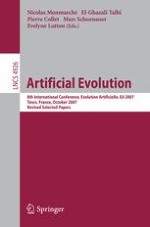2008 | Buch
Artificial Evolution
8th International Conference, Evolution Artificielle, EA 2007, Tours, France, October 29-31, 2007, Revised Selected Papers
herausgegeben von: Nicolas Monmarché, El-Ghazali Talbi, Pierre Collet, Marc Schoenauer, Evelyne Lutton
Verlag: Springer Berlin Heidelberg
Buchreihe : Lecture Notes in Computer Science
